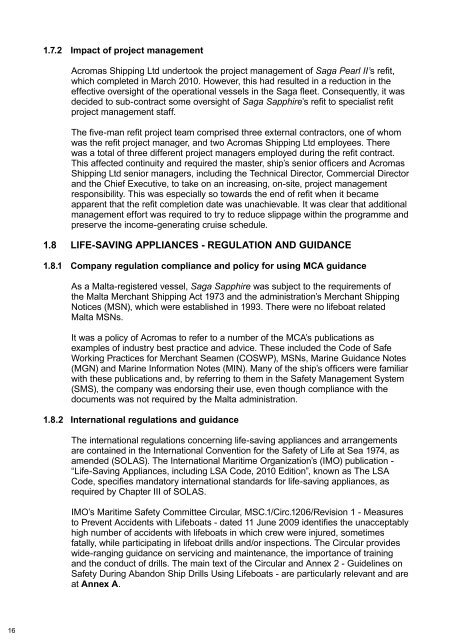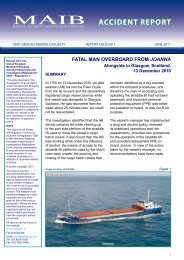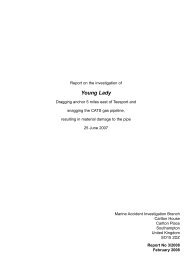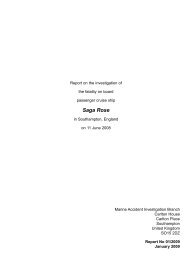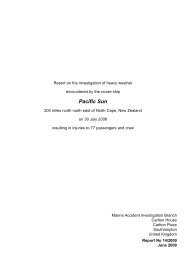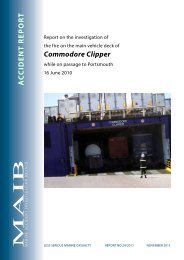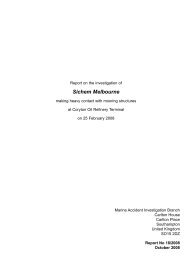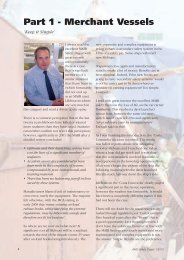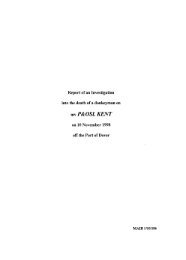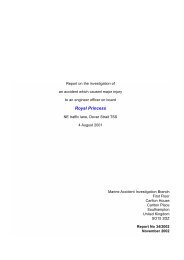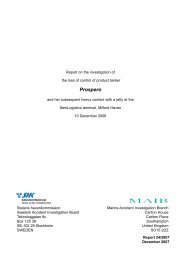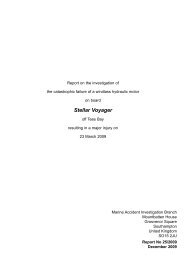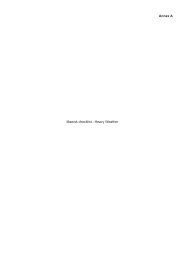SECTION 4 - Marine Accident Investigation Branch
SECTION 4 - Marine Accident Investigation Branch
SECTION 4 - Marine Accident Investigation Branch
Create successful ePaper yourself
Turn your PDF publications into a flip-book with our unique Google optimized e-Paper software.
16<br />
1.7.2 Impact of project management<br />
Acromas Shipping Ltd undertook the project management of Saga Pearl II’s refit,<br />
which completed in March 2010. However, this had resulted in a reduction in the<br />
effective oversight of the operational vessels in the Saga fleet. Consequently, it was<br />
decided to sub-contract some oversight of Saga Sapphire’s refit to specialist refit<br />
project management staff.<br />
The five-man refit project team comprised three external contractors, one of whom<br />
was the refit project manager, and two Acromas Shipping Ltd employees. There<br />
was a total of three different project managers employed during the refit contract.<br />
This affected continuity and required the master, ship’s senior officers and Acromas<br />
Shipping Ltd senior managers, including the Technical Director, Commercial Director<br />
and the Chief Executive, to take on an increasing, on-site, project management<br />
responsibility. This was especially so towards the end of refit when it became<br />
apparent that the refit completion date was unachievable. It was clear that additional<br />
management effort was required to try to reduce slippage within the programme and<br />
preserve the income-generating cruise schedule.<br />
1.8 LIFE-SAVING APPLIANCES - REGULATION AND GUIDANCE<br />
1.8.1 Company regulation compliance and policy for using MCA guidance<br />
As a Malta-registered vessel, Saga Sapphire was subject to the requirements of<br />
the Malta Merchant Shipping Act 1973 and the administration’s Merchant Shipping<br />
Notices (MSN), which were established in 1993. There were no lifeboat related<br />
Malta MSNs.<br />
It was a policy of Acromas to refer to a number of the MCA’s publications as<br />
examples of industry best practice and advice. These included the Code of Safe<br />
Working Practices for Merchant Seamen (COSWP), MSNs, <strong>Marine</strong> Guidance Notes<br />
(MGN) and <strong>Marine</strong> Information Notes (MIN). Many of the ship’s officers were familiar<br />
with these publications and, by referring to them in the Safety Management System<br />
(SMS), the company was endorsing their use, even though compliance with the<br />
documents was not required by the Malta administration.<br />
1.8.2 International regulations and guidance<br />
The international regulations concerning life-saving appliances and arrangements<br />
are contained in the International Convention for the Safety of Life at Sea 1974, as<br />
amended (SOLAS). The International Maritime Organization’s (IMO) publication -<br />
“Life-Saving Appliances, including LSA Code, 2010 Edition”, known as The LSA<br />
Code, specifies mandatory international standards for life-saving appliances, as<br />
required by Chapter III of SOLAS.<br />
IMO’s Maritime Safety Committee Circular, MSC.1/Circ.1206/Revision 1 - Measures<br />
to Prevent <strong>Accident</strong>s with Lifeboats - dated 11 June 2009 identifies the unacceptably<br />
high number of accidents with lifeboats in which crew were injured, sometimes<br />
fatally, while participating in lifeboat drills and/or inspections. The Circular provides<br />
wide-ranging guidance on servicing and maintenance, the importance of training<br />
and the conduct of drills. The main text of the Circular and Annex 2 - Guidelines on<br />
Safety During Abandon Ship Drills Using Lifeboats - are particularly relevant and are<br />
at Annex A.


